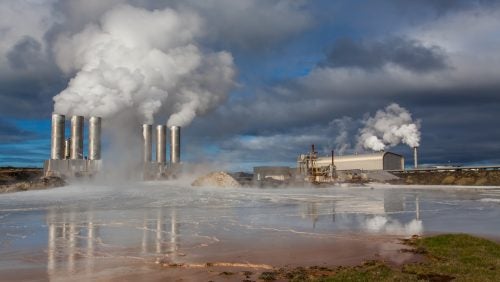The DOE Wants to Cut the Cost of Geothermal by 90%. Simplifying Geothermal Permitting Could Help it Get There.
November 14, 2022 by Diego Huerta

A geothermal plant with steam.
The Infrastructure Investment and Jobs Act (A.K.A. the Bipartisan Infrastructure Bill) provides 84 million dollars over the next three years to the Department of Energy (DOE) for Enhanced Geothermal Systems (EGS) research and development.[1] EGS are used to extract geothermal heat from reservoirs that otherwise would not be feasible for energy production due to their low-permeability and/or low-porosity.[2] Using that money, the DOE’s Office of Energy Efficiency and Renewable Energy has announced an initiative to decrease the cost of geothermal energy by 90% down to $45 per megawatt hour by 2035, and will establish pilot programs to study EGS technology at four sites.[3]
It is estimated that only a small fraction of current EGS potential is currently utilized, and that the total EGS resources of the U.S. are around 2,000 times greater than the primary energy consumed by the U.S. in 2005.[4] While the U.S. is the number one producer of geothermal energy in the world, geothermal plants currently serve a negligible fraction of U.S. energy generation needs (0.4%).[5] One reason for this is the significant upfront costs, including regulatory costs, associated with geothermal development.[6] However, geothermal energy has a number of positive qualities that could make it a critical part of our future renewable energy mix. Critically, unlike wind and solar, geothermal is “always on” and thus can supply baseload power day and night.[7][8] Additionally, because EGS uses methods that are also used by the oil and gas industry, some abandoned oil and gas wells can be converted to geothermal wells,[9] making geothermal jobs accessible to skilled oil and gas workers as the nation transitions to a renewable economy.[10]
While the DOE has said that “[p]rinciples of equity and justice will guide” its implementation of the program and, consistent with President Biden’s Justice40 initiative, 40% of the benefits of the program will flow to disadvantaged communities, [11] there remain important environmental justice concerns for geothermal development.
Geothermal projects, due to their use of oil and gas techniques to engineer aquifers for production, are subject to well-founded concerns about local effects such as induced seismicity and land subsidence as well as groundwater pollution.[12] Further, while EGS systems can recycle water used for electricity generation, they do require some water for their operation. Because most geothermal resources are in the West, which is experiencing drought due to climate change,[13] this water demand is not inconsequential. While these environmental effects are important to consider, geothermal is nevertheless considered one of the most benign energy sources available, even among renewables.[14]
Permitting demands on geothermal plant construction are a significant impediment to the growth of geothermal energy production. Development of geothermal plants usually requires multiple federal and state permits, and members of the geothermal industry have indicated that a lack of coordination and government expertise can delay the permitting process of a geothermal plant.[15] Despite the significantly less hazardous effects of geothermal plants, the federal permitting process for geothermal plants is similar to oil and gas permitting,[16] and permitting reviews can delay project implementation by a year or more.[17] Thus, as geothermal technology advances, it appears that the geothermal permitting process must advance as well if the DOE is going to hit its 90% cost reduction target.
[1] Infrastructure Investment and Jobs Act, Pub L. 117-58, 135 Stat. 1129 (2021).
[2] See U.S. Dep’t of Energy, Request for Information (RFI) DE-FOA-0002749, 3 (2022) https://eere-exchange.energy.gov/FileContent.aspx?FileID=29f8b2df-dd7c-4bf1-ab71-0a28dc410b65 (last visited Oct. 22, 2022).
[3] U.S. Dep’t of Energy, DOE Launches New Energy Earthshot to Slash the Cost of Geothermal Power (2022),https://www.energy.gov/articles/doe-launches-new-energy-earthshot-slash-cost-geothermal-power (last visited Oct. 22, 2022).
[4] See The Future of Geothermal Energy: Impact of Enhanced Geothermal Systems (EGS) on the United States in the 21st Century, Massachusetts Inst. of Tech. 18 (2006). https://www1.eere.energy.gov/geothermal/pdfs/future_geo_energy.pdf (last visited Oct. 22, 2022).
[5] Geothermal Energy Factsheet Pub. No. CSS10-10, Univ. of Mich. Ctr. for Sustainable Sys. (2022) https://css.umich.edu/sites/default/files/2022-09/Geothermal%20Energy_CSS10-10.pdf (last visited Oct. 22, 2022).
[6] See Morgan Smith, Cong. Research Serv., R47256, Enhanced Geothermal Systems: Introduction and Issues for Congress 13 (2019).
[7] See U.S. Dep’t of Energy, supra note 2, at 3.
[8] See U.S. Dep’t of Energy, supra note 3.
[9] See Xianbiao Bu et al., Geothermal Energy Production Utilizing Abandoned Oil and Gas Wells, Renewable Energy (2012), https://doi.org/10.1016/j.renene.2011.10.009 (last visited Oct. 22, 2022).
[10] See U.S. Dep’t of Energy, supra note 3.
[11] U.S. Dep’t of Energy, supra note 2, at 2.
[12] See e.g. National Research Council, Electricity from Renewable Resources: Status, Prospects, and Impediments, The Nat’l Academies Press 95 (2010), https://doi.org/10.17226/12619 (last visited Oct. 22, 2022); Ronald Dipippo, Geothermal Power Plants: Principles, Applications, Case Studies and Environmental Impact 504 (3rd ed. 2012).
[13] Noah S. Diffenbaugh et al., Anthropogenic warming has increased drought risk in California, Proceedings of the Nat’l Acad. of Sciences (2015), https://www.pnas.org/doi/full/10.1073/pnas.1422385112 (last visited Oct. 22, 2022).
[14] Ronald Dipippo, supra note 13 at XIX, 504.
[15] Katherine Young et al., An Analysis of Non-Technical Barriers to Geothermal Deployment and Potential Improvement Scenarios, GeoVision Analysis Supporting Task Force Report: Barriers, Nat’l Renewable Energy Lab’y 50 (2019), https://www.nrel.gov/docs/fy19osti/71641.pdf (Last visited Oct. 22, 2022).
[16] National Research Council, supra note 12, at 224.
[17] Katherine Young et al, supra note 15, at 34.

